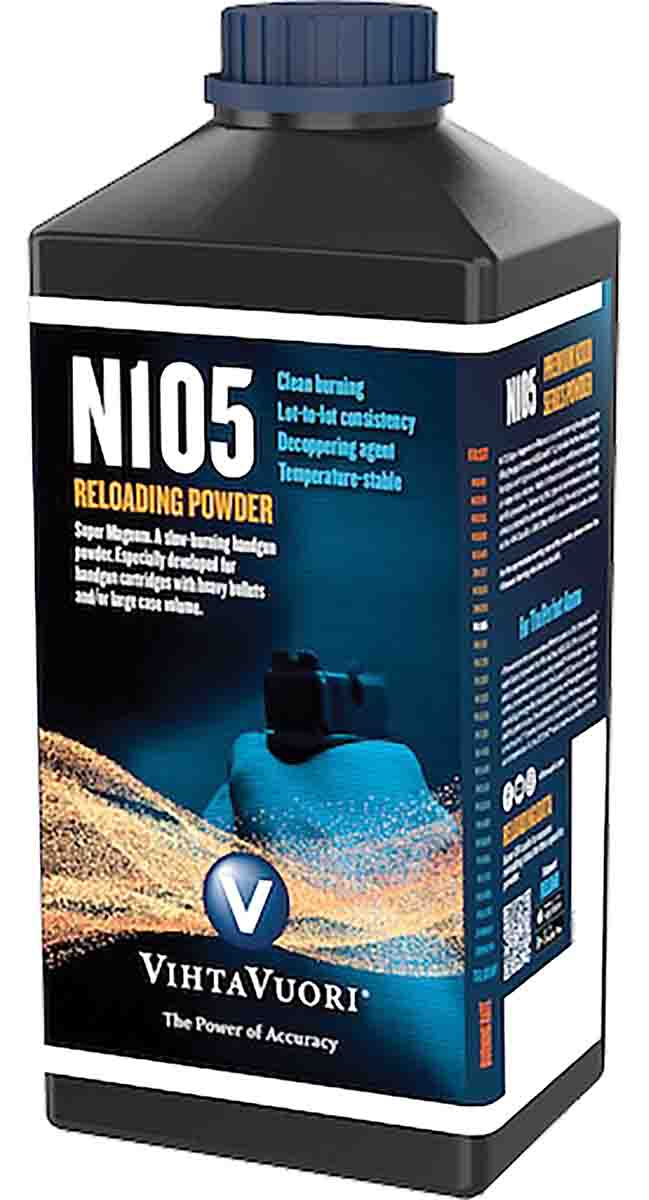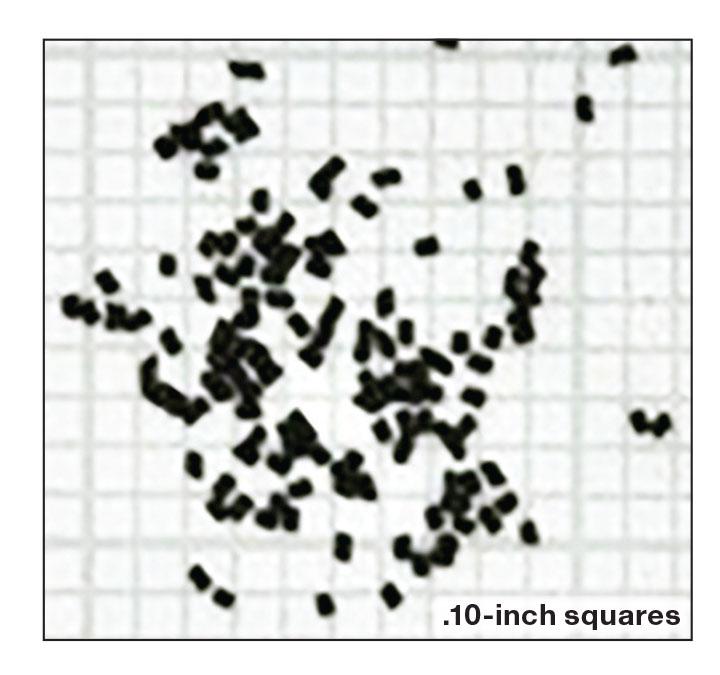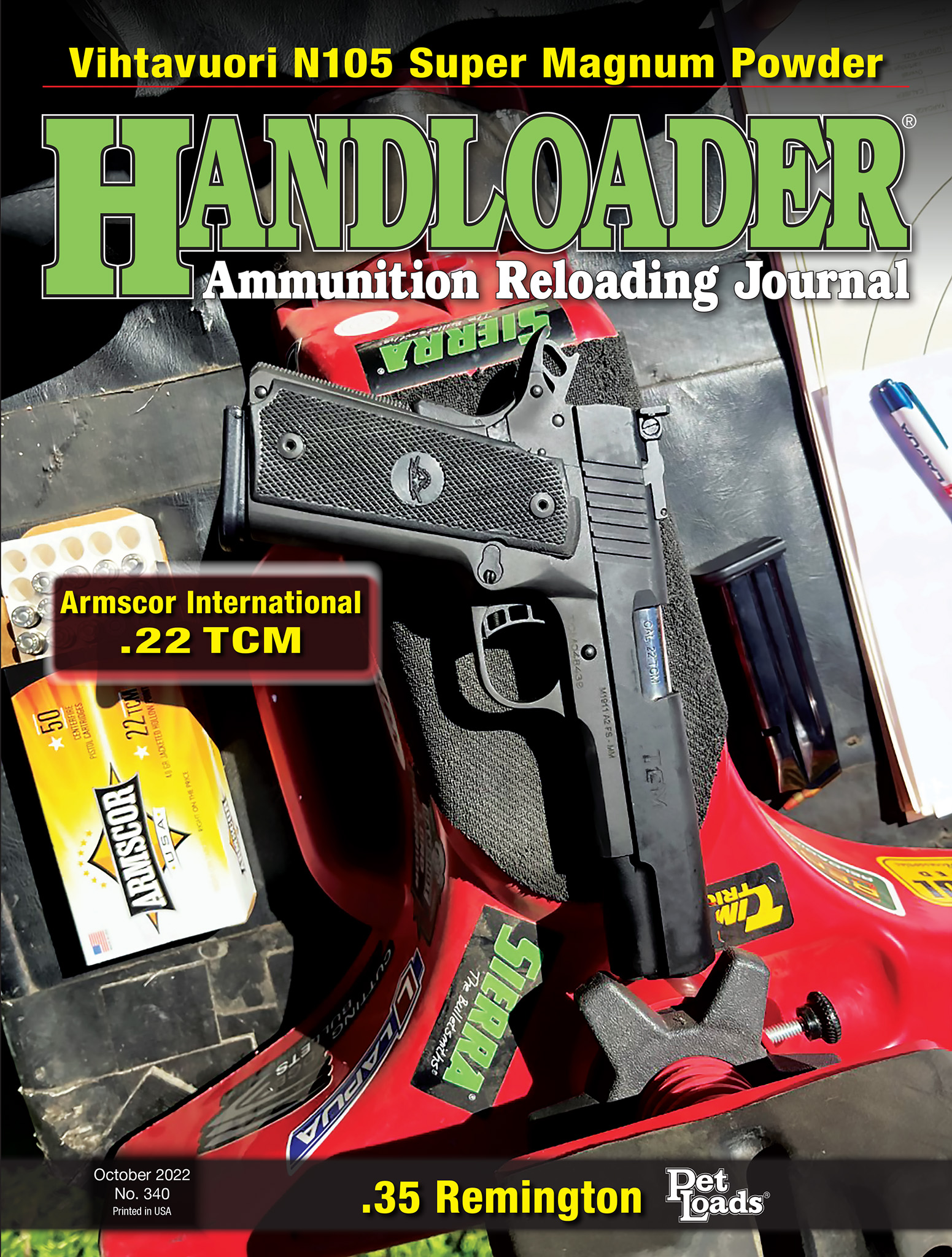Propellant Profiles
Vihtavuori N105 Super Magnum
column By: R.H. VanDenberg, Jr. | September, 22

Vihtavuori is a relatively new propellant manufacturer to the North American handloading market, first coming to the U.S. commercially in 1990, but it has a long history dating back 100 years to 1922 when the company was established in the small town of Laukaa, Finland. Not everyone on this side of the Atlantic Ocean is as familiar with the Vihtavuori brand as they are with Alliant, Hodgdon, IMR and Winchester; but in that short 30-year period, Vihtavuori has established a solid reputation for manufacturing propellants that exhibit exacting ballistic performance and consistency. Be it the big game or varmint hunter, handgun, or rifle competitor, Vihtavuori has established a solid following.
Super Magnum is a relatively slow-burning pistol powder particularly useful with heavy bullets and/or cartridges with larger case volumes. Many of these specialized rounds operate at rifle pressures. Delivering this type of performance is precisely what prompted the development of VV-N105. A special use powder of sorts, I find VV-N105 is an excellent powder for loading cartridges such as the 9mm Luger and .38 Super with heavy-for-caliber bullets, the .357 Magnum, .41 Magnum, .44 Magnum, .50 Action Express and powerhouses like the .454 Casull and .500 S&W.
Characteristic-wise, Super Magnum is a single-base powder with the principal chemical components being, nitrocellulose as the primary energizer, diphenylamine and diethyldiphenylurea along with a proprietary decoppering (anti-fouling) agent. Graphite is added to the surface of the powder granules during the drying process to eliminate static electricity and make the finished powder flow consistently through powder measures.
The powder granules are a very light gray in color and are a very short-cut solid stick extrusion, measuring .063 inch in length and .029 inch in diameter. The short compact sticks aid in very consistent charges when dispensed from a powder measure and are less prone than some spherical powders to “leakage” in some electronic powder dispensers. The bulk density of N105 Super Magnum is 0.7 g/cc and the energy content is 3,950 J/g (Joules per gram).
Vihtavuori divides its propellants imported into the U.S. into three main categories: single-base powders, generally considered for use in rifle cartridges, are the N100 series; single-base powders for handguns are the N300 series; and the N500 series, double-base powders, again for rifles. Vihtavuori’s classification of VV-N105 Super Magnum is interesting. In the Vihtavuori reloading guide, I did not find N105 with the other N100 series powders, but rather with the N300 series powders. In a confusing way, it makes sense as VV- N105 Super Magnum’s principal use is in handgun cartridges. In fact, I have found loading data using N105 for only one traditional rifle cartridge, the .300 Blackout.

I have great results in my 9mm Luger Browning High Power with 6.2 grains of Super Magnum ignited by Winchester Small Pistol primers and pushing the heavy-for-caliber Hornady 147-grain HP/XTP at 1,125 feet per second (fps). In a 1911 Government Model .38 Super, 8.1 grains of VV-N105 Super Magnum, combined with the same primer and bullet combination as the 9mm Luger load, drives the 147-grain XTP at 1,204 fps from the 5-inch barrel. In a 6-inch barreled Smith and Wesson Model 686, VV-N105 Super Magnum really shines with a combination of 12 grains of VV-N105, Winchester Small Pistol Magnum primer and the Hornady 158-grain XTP bullet clocking 1,435 fps over my Oehler 35P chronograph.
In the big bore category, I load for a friend’s rifle that I lust for, a Big Horn Armory Model 90A. The Model 90A is a modern, beautiful lever-action rifle embodying the best of the J.M. Browning designed Winchester Model 1886/1892 lever-actions and chambered in .454 Casull. As Brain Pearce found in his test and evaluation of the Big Horn Armory Model 90A .454 Casull in the Rifle No. 303 (March-April 2019), so too is this Model 90A relatively immune to the effects of barrel heating with successive shots and/or variations in bullet or powder choices. That being said, the Speer 300-grain DeepCurl hollowpoint launched by 22.9 grains of VV-N105 Super Magnum, initiated by a Federal 205M primer at 1,910 fps, constantly produces five-shot groups measuring 1.250 inches or less at 100 yards off the bench.
While maybe not quite as desirable as a Big Horn Armory Model 90A, I have a Marlin Model 1894-P in .44 Magnum that is an extremely versatile and handy rifle. The Model 1894-P was the Model 1894 series equivalent of the Marlin’s 1895 “Guide Gun” and sports a 16.5-inch ported barrel. Produced for only two years (2000-2001), I ran across this rifle in Iowa City a while back, when the weather turned bad and rained out our day of pheasant hunting. We swung by Sheel’s Sporting Goods to see what they might have of interest in the gun library, and I got sidetracked when I saw the 1894-P with absolutely gorgeous wood on the new gun rack. I asked the clerk if I could dry-fire it. The trigger measured 2.5 pounds and I purchased it.
The little Marlin’s all-time favorite load is 16.5 grains of VV-N105 Super Magnum over a Winchester WLPM primer and topped off with a Sierra 240-grain Sports Master JHC bullet. Unlike the Big Horn 90A, the Marlin 1895-P is a little finicky about barrel heat, so I limit groups to three shots rather than the five-shot groups fired with the Big Horn Armory Model 90A. Fitted out with a Brockman Rifles Gen III Winged Ghost Ring Sight, set the 1894-P will keep the three-shot groups in 1.25- to 1.50- inch groups at 100 yards. The Oehler 35P chronograph clocks this load at 1,705 fps.
Now, the bad news. Just days before going to press, I spoke with the good folks at Capstone Precision Group, Vihtavuori’s U.S. importer/distributor. While Vihtavuori manufactures a staggering number of propellants for military and civilian markets, Vihtavuori’s parent company, Nammo Lapua Oy, has worked closely with Capstone Precision to address the ongoing supply chain issues by concentrating on producing and delivering propellants most relevant to the U.S. sporting market. Most recently, the Vihtavuori 2021 Reloading Guide listed 29 powders, while the available list of powders in the 2022 Reloading Guide has been reduced to 14 powders.
VV-N105 Super Magnum, N32C-Tin Star (Cowboy Action Shooting loads), W-N160, N165, N170, 24N21, 20N29, N340, N350, 3N37, 3N38 and N530 have all been cut from the powders being imported to service the North American market. If, like me, you have a need for N105 Super Magnum or one of the other Vihtavuori powders being dropped, the time is now to buy what you need while there are still quantities on dealer’s shelves. N105 Super Magnum is packaged in 1-pound canisters when you can find it.
.jpg)


